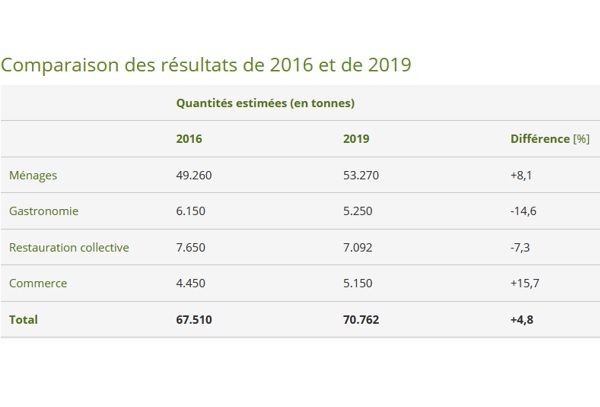 Comparison of food waste in different areas;
Credit: Environment Agency
Comparison of food waste in different areas;
Credit: Environment Agency
According to a study carried out by the Environment Agency, Luxembourg threw away a total of 70,762 tonnes of food in 2019.
Since 2013, the Environment Agency, in cooperation with Eco-Conseil SARL, has been carrying out the study "Generation, treatment and avoidance of food waste" in Luxembourg. In order to understand exactly which food ends up in the waste, the study is divided into four areas of origin: private households; retail; large kitchens; gastronomy. The results are considered as a starting point to counteract food waste in all these areas.
The generation and composition of food waste in Luxembourg was estimated using data from various waste statistics, as well as the results of a survey of selected companies in the food distribution and processing chain, those of the nationwide residual waste analysis 2018/2019 and a series of secondary and tertiary data.
The study found that restaurants, retailers, large kitchens and private households throw away around 70,800 tonnes of food, i.e. around 118 kg per inhabitant, per year. Whilst the total volume of food in residual waste has increased slightly since 2016, due to the increasing population (+4.8%), the per capita volume has decreased (-3.8%).
The majority of food waste was generated in private households: in Luxembourg, 53,270 tonnes of food are disposed of in residual waste, organic waste bins and compost every year. That represents around 75% of all food waste. Each of the 602,000 inhabitants thus produces an average of 88.5 kg of food waste per year (as of 2018), of which around 23.5 kg per capita (14,200 tonnes) would have been avoidable.
In addition, the avoidable share of food waste in residual waste decreased by around 37%. The Environment Agency suggested that this was due to increased awareness and changed habits, such as composting or separating organic waste.
The residual waste study carried out in 2019 showed that there is a high proportion of food (up to 30%) in residual waste. In monetary terms, the avoidable food waste disposed of as residual waste is estimated at €75.5 per inhabitant per year, or €46.5 million euros per year for the whole of Luxembourg.
In the catering industry, food waste mainly consists of largely unavoidable preparation leftovers (eggshells, fat, bones, etc.), but also avoidable table leftovers, excess meals or storage losses. The total amount of food waste in gastronomy was calculated on average at 5,250 tonnes per year. This results in an annual volume of 8.9 kg per resident. About 7.1 kg of this per resident per year could be avoided.
The total amount of food waste in large kitchens (canteens, hospitals, schools, retirement homes, etc.) was calculated at an average of 7,100 tonnes per year. This results in an annual volume of 12 kg per resident. Around 9.6 kg of this per resident per year could be avoided. These new figures correspond to a decrease in food waste in this area of around 8%. According to respondents, this decline is due to an increased awareness of the issue of food waste and increased initiatives in this area.
In retail and wholesale, food waste occurs primarily in the form of products that are classified as no longer for sale (spoiled food, past the expiration date). The total amount of food waste in retail was calculated to be an average of 5,150 tonnes per year - not including food donations. The estimated quantities therefore only include unsold food. This results in an annual volume of 8.7 kg per inhabitant. Around 7.85 kg of this per inhabitant per year could be avoided.








